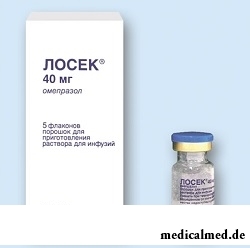





Losek
Application instruction:
 Losek – antiulcerous medicine.
Losek – antiulcerous medicine.
Form of release and structure
Dosage form of drug – lyophilisate for preparation of solution for infusions (on 40 mg in 1 bottle, in a cardboard pack of 5 bottles).
Contain in 1 bottle:
- Active ingredient: омепразол sodium – 42,6 mg (corresponds to the maintenance of an omeprazol – 40 mg);
- Auxiliary components: sodium ethylene diamine tetraacetate, sodium hydroxide (for correction рН).
Indications to use
Drug is shown for intravenous administration as replacement of peroral dosage forms of an omeprazol at therapy of the following diseases:
- Gastrinoma (Zollingera-Ellison's syndrome);
- Peptic ulcer of a stomach;
- Peptic ulcer of a duodenum;
- Reflux esophagitis.
Contraindications
- Combined use with nelfinaviry and atazanaviry;
- Children's age (experience of use is limited);
- Hypersensitivity to benzimidazole derivatives, an omeprazol or to other components of lyophilisate.
As a result of a number of researches lack of side effects of an omeprazol on pregnancy therefore drug is allowed for use during this period is revealed.
At a lactation for the period of therapy breastfeeding needs to be stopped as омепразол gets into breast milk, and its influence on children is not studied.
Route of administration and dosage
Lyophilisate solution right after preparation should be entered intravenously, in the form of infusion, for 20-30 minutes.
Doses are selected the attending physician individually. If a required daily dose more than 60 mg, then it is necessary to divide it into two introductions.
It is recommended (if oral administration of an omeprazol is impossible) at a peptic ulcer of a stomach and duodenum or a reflux esophagitis infusional introduction of Losek in a dose of 40 mg of 1 times a day. At Zollingera-Ellison's syndrome the initial dose makes 60 mg of 1 times a day.
Patients with abnormal liver functions can reduce a daily dose to 10-20 mg, it has to be enough as they increased T1/2 – an elimination half-life of an omeprazol.
At renal failures and the patient of advanced age dose adjustment is not required.
For cultivation of 1 bottle of lyophilisate Losek 5% infusion solution of a dextrose or infusional 0,9% chloride sodium solution of 100 ml are used.
Solutions prepare without special precautions at room lighting as follows:
- In the prepared syringe to gain 5 ml of infusion solution from an infusional bag or a bottle;
- To enter infusion solution into a bottle with lyophilisate Losek, to stir up a bottle before full dissolution of powder;
- To gather the dissolved lyophilisate in the syringe;
- To transfer solution of an omeprazol to an infusional bag or to a bottle;
- To repeat actions with 1 on 4 to transfer all drug from a bottle.
Other way of preparation of infusion solution using a soft container:
- To use a bilateral needle adapter, having punctured with one of its end a membrane of an infusional bag, having connected other end to a lyophilisate bottle;
- Pumping over infusion solution from a bag in a bottle and to back dissolve the lyophilized powder;
- After full dissolution of powder to disconnect an empty bottle and to take out a needle from an infusional bag.
Side effects
The side effects noted during clinical trials and at post-marketing studying of use of lyophilisate Losek, which are not depending on the mode of its dosing:
- Gepatobiliarny system: infrequently – increase in activity of liver enzymes; seldom – hepatic encephalopathy at patients with liver diseases, hepatitis with jaundice or without it;
- Digestive Tract (DT): often – nausea, vomiting, diarrhea, a meteorism, a lock, abdominal pain; seldom – gastrointestinal candidiasis, dryness in a mouth, stomatitis;
- Immune system: seldom – hypersensitivity reactions, such as an angioedema, fever, an anaphylaxis;
- Skin and hypodermic cellulose: infrequently – urticaria, dermatitis, skin rash, a skin itch; seldom – photosensitivity reactions, an alopecia, Stephens-Johnson's syndrome, a toxic epidermal necrolysis, a multiformny erythema;
- Hemopoietic system: seldom – a leukopenia, an agranulocytosis, thrombocytopenia, a pancytopenia;
- Urinary system: seldom – intersticial nephrite;
- Nervous system (central and peripheral): often – a headache; infrequently – paresthesias, dizziness, drowsiness, sleeplessness; seldom – aggression, hypererethism, a depression, hallucinations, consciousness disturbance, taste disturbance;
- Musculoskeletal system: seldom – a mialgiya, an arthralgia, muscular weakness;
- Respiratory organs: seldom – a bronchospasm;
- Reproductive organs: seldom – a gynecomastia;
- Another: infrequently – a febricula, вертиго; seldom – a sight illegibility, a hyponatremia, peripheral hypostases, the increased sweating; very seldom – a hypomagnesiemia.
Patients have data on an irreversible vision disorder with the heavy accompanying pathologies against the background of injections of an omeprazol in high doses, but to a reliable causal relationship between therapy omeprazoly and deterioration in sight was not established.
By results of clinical trials it was established that intravenous infusional administration of drug in a daily dose to 270 mg, and also to 650 mg within three days for the patient took place without any significant effects.
Can be symptoms of overdose: block, confusion of consciousness, dizziness, headache, tachycardia, dilatation of vessels, nausea, vomiting, diarrhea, meteorism. It is in that case recommended to carry out symptomatic therapy, considering insufficient efficiency of a hemodialysis.
Special instructions
In the presence of suspicions of stomach ulcer it is necessary to undergo endoscopic or x-ray inspection at early stages for establishment of the right diagnosis and purpose of adequate therapy.
It is required to exclude a possibility of malignant new growths at any alarming symptoms (a dysphagy, frequent vomiting, a melena or vomiting with blood, essential spontaneous loss of weight), and also at stomach ulcer or in case of suspicion of stomach ulcer as therapy omeprazoly can lead to weakening of symptomatology and postpone diagnosis.
It is important to consider that inhibitors of the proton pump can increase risk of development of one of the most frequent nozokomialny infections caused by Clostridium difficile microorganism at hospital patients.
Omeprazol does not influence concentration of attention and speed of psychomotor reactions, but during therapy drowsiness and dizziness therefore it is recommended to be careful at control of motor transport or work with other difficult mechanisms can be observed.
Medicinal interaction
Influence of an omeprazol on at the same time applied medicinal substances / drugs:
- Klopidogrel – can decrease his protivotrombotichesky action (the interaction mechanism is completely not studied for today therefore it is recommended to be careful at combined use);
- Ketokonazol or итраконазол – decrease in their absorption is possible;
- Digoxin – increase in its absorption; at combined use of an omeprazol in a daily dose of 20 mg and digoxin bioavailability of the last increases by 10% (at 20% of patients – to 30%);
- Nelfinavir and атазанавир – is marked out decrease in their concentration in serum (combined use with omeprazoly is not recommended);
- Sakvinavir – raises its concentration in serum;
- Diazepam, warfarin, Phenytoinum, other antagonists of vitamin K and цилостазол – decrease in their metabolism is possible (Phenytoinum – is necessary control of its concentration in plasma; warfarin, other antagonists of vitamin K – is required monitoring of an index of the international normalized relation (MHO));
- Lidocaine, quinidine, cyclosporine, erythromycin, oestradiol and будесонид – омепразол does not influence their metabolism;
- Theophylline, caffeine, quinidine, diclofenac, piroxicam, Naproxenum, propranolol, метопролол, ethanol – influence of an omeprazol is not revealed;
- Takrolimus – raises its concentration in blood serum.
Influence of substances/drugs on pharmacokinetics of an omeprazol:
- Vorikonazol and кларитромицин – because of decrease in metabolism of an omeprazol increase in its concentration in a blood plasma (taking into account good tolerance of high doses of an omeprazol of their correction it is not required in case of short combined use) is possible;
- Drugs of the St. John's Wort which is made a hole rifampicin – due to acceleration of metabolism of an omeprazol can reduce its concentration in a blood plasma.
Terms and storage conditions
To store in original packaging, in the protected from light, dry place, at a temperature not above 25 °C. To protect from children.
Period of validity:
- For 5% to a dextrose – to use infusion solution within 6 hours;
- For 0,9% chloride sodium solution – to use infusion solution within 12 hours;
- Bottle unpacked (at room lighting, in the place protected from light) – no more than 24 hours;
- Bottle in original packaging – 2 years.
Name of drug
Price
Drugstore
The most high temperature of a body was recorded at Uilli Jones (USA) who came to hospital with a temperature of 46,5 °C.

Contrary to popular belief, the multiple sclerosis (MS) is not connected neither with sclerous changes of walls of vessels, nor about age...
Section: Articles about health
The sclera and mucous membrane of an eye are intensively supplied with blood vessels which problem - to saturate nervous tissues of body with nutrients and oxygen. In a normality vessels are almost not noticeable, however at their expansion (owing to истонч...
Section: Articles about health
The immunity role in growth of the child is invaluable. The proteins-immunoglobulins produced by immune system preserve the child against the diseases capable − owing to an organism weak still − to serve as a stressful factor, to become the reason of many complications and delays in development of the kid. If the immune system weakened, health of the child is under direct threat and needs active actions for strengthening of protective forces of an organism − preferably non-drug....
Section: Articles about health
In consciousness of our many compatriots idea that folk remedies if no more эфф strongly took roots...
Section: Articles about health
The problem of diagnosis was and remains to one of the most important in medicine. From that, the reason of an indisposition of the patient will be how precisely defined, eventually success of treatment depends. In spite of the fact that the majority of the diagnostic methods applied in about...
Section: Articles about health
You are office worker, the driver, the fan of winter sports or do not think of life without bicycle? You lead a slow-moving life and you move on the city only on the car? You have no constant partner and you do not love the protected sex? Attention! You unambiguously are a potential target for prostatitis. It is not necessary to panic, it is necessary to work....
Section: Articles about health
Cellulitis - very widespread cosmetic shortcoming which arises approximately at 80% of women sooner or later. Emergence ег...
Section: Articles about health
Extracorporal fertilization – one of the most modern methods of controlling with infertility. So far he already helped a significant amount of married couples to become happy parents. Usually to the EKO procedure difficult and very expensive, resort in those...
Section: Articles about health
What woman does not dream of a beautiful and thick hair? While physicians developed difficult schemes on hair transplant, in the industry of hairdresser's art a few years ago there was a sensation – methods of hair extension appeared. It would seem, dreams came true: though the procedure of building also does not belong to the category cheap, practically any woman can increase several times the volume of hair, change their length and color – generally, to become the real beauty queen....
Section: Articles about health
Statistically, at the address to doctors seven of each ten patients complain of a headache. Actually people, periodically...
Section: Articles about health
The popular expression "run from a heart attack" became the motto of the people supporting active lifestyle. Moreover, run became a peculiar fashionable tendency: sales of racetracks and the accompanying goods for run are at permanently high level. Really...
Section: Articles about health
Phobia – the persuasive fear of a certain contents shown in a specific situation against the will of the person. Concepts of a phobia and fear are similar, however if the fear is natural protective function of mentality, then the phobia is its deviation. So the person can feel the unaccountable, baseless fear accompanied with neurotic symptoms (perspiration, a shiver, a fever) before any ordinary phenomenon – for example, a trip by the subway or a simple dog....
Section: Articles about health
Herpes simplex of the first type (the infectious disease which is shown periodic bubble rashes on is called...
Section: Articles about health
For the city dweller the fitness is the most convenient sport. It is enough to acquire the subscription to the gym to get access to various apparatuses and an opportunity to train under the leadership of the experienced consultant. Many consider fitness on...
Section: Articles about health
The state of health of the person in many respects depends on chemical composition of biological liquids of an organism. Specialists consider that PH value of these solutions has to be in range of 7,35-7, 45. The deviation in the smaller party (so-called "acidulation") is fraught with development of many heavy illnesses, failures in work of immune system, decrease in working capacity and deterioration of life. To avoid serious fluctuations of acidity of internal liquids it is necessary to adhere разумног...
Section: Articles about health
Food with the increased content of sugar is attractive to most of people - it is scientifically confirmed fact. Business here not in a nevozder...
Section: Articles about health
Popular joke that there are no healthy people, and is nedoobsledovanny, most of us considers an honest truth, continually it is necessary to hear that all of us are sick hardly from a school bench. It is hard to say, whether so it actually because...
Section: Articles about health
The unpleasant feelings connected with spring breakdown are familiar almost to each of us. Often happens that in March-April on the person weakness leans: he suffers from drowsiness, complains of bad mood, loss of interest in life and failures in affairs....
Section: Articles about health
Dietary supplements (dietary supplements) for the last decades were so thoroughly included into our life that, apparently, it is already impossible on...
Section: Articles about health
The varicosity has familiarly many, statistically, this disease more than a half of all adult population. As a rule, the varicosis affects preferential superficial vessels, and is shown by characteristic cosmetic defects. Guo...
Section: Articles about health
Many of us, probably, noticed more than once that from intellectual loadings at some point the brain as though "overheats" and "assimilation" of information is strongly slowed down. Especially this problem urgent for persons of age becomes more senior than fifty years. "Already badly I think", "the head will burst now", "memory as if is disconnected" - here that wants to be told at the time of information overload....
Section: Articles about health
About 10-15 years ago existence of the computer in the apartment of the Russian was considered as a rarity and office rooms were only on перв...
Section: Articles about health
Urogenital candidiasis (milkwoman) – a fungal infection which annoys unpleasant feelings in the field of generative organs, being followed by white curdled allocations, an itch, discomfort during an urination, pain. She is called by Candida fungus – a mustache...
Section: Articles about health
One of the major chemical processes happening in a human body are oxidation reactions. They go with participation of fats and carbohydrates which we receive from food, and the oxygen getting to us from air. A main goal of such reactions is obtaining the energy necessary for life activity. Unfortunately, as a result of these processes dangerous by-products – so-called free radicals are allocated. To minimize harm which they can cause to the person neo...
Section: Articles about health
About influence of fasting days on an organism it is told much – both about advantages, and about shortcomings. It is considered that fasting day...
Section: Articles about health
It is difficult to revaluate importance of kidneys for an organism. These bodies not only perform work on purification of blood of decomposition products and removal of excess liquid. They are responsible also for production of some hormones necessary for normality maintenance...
Section: Articles about health
Wood louse – the ordinary-looking unpretentious plant extended in all territory of our country. It quickly expands, and sometimes fills sites, bringing a lot of chagrin to gardeners. Perhaps, they would be upset less if knew that the wood louse is valuable medicinal raw materials. A, C and E vitamins, organic acids, tannins, wax, saponins, lipids, mineral salts and essential oils are its part....
Section: Articles about health


